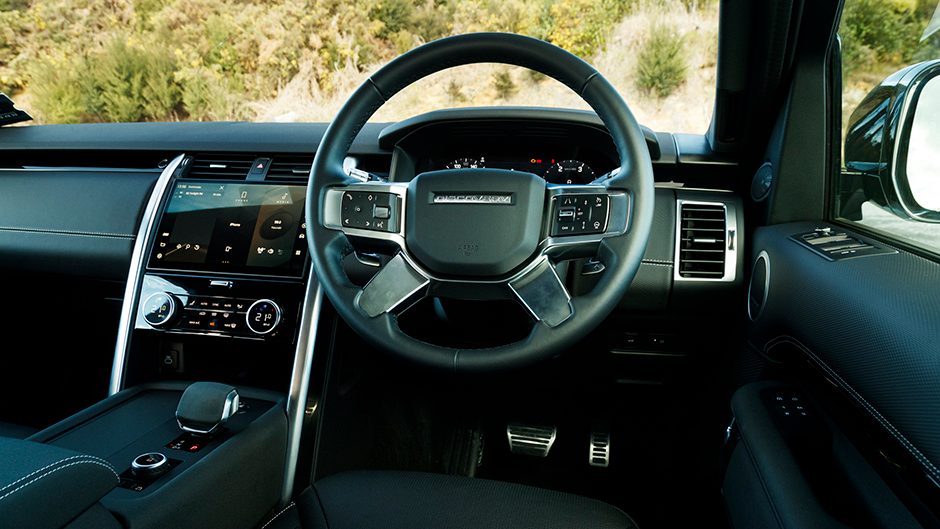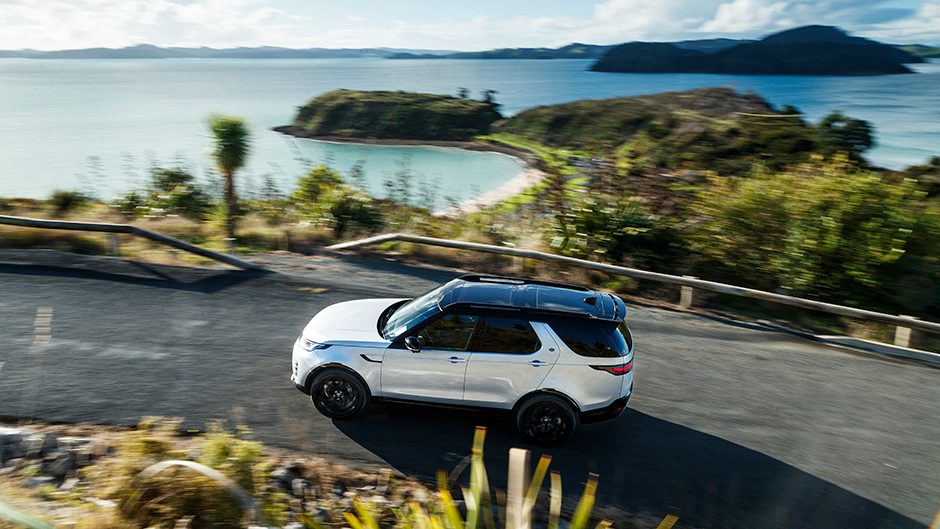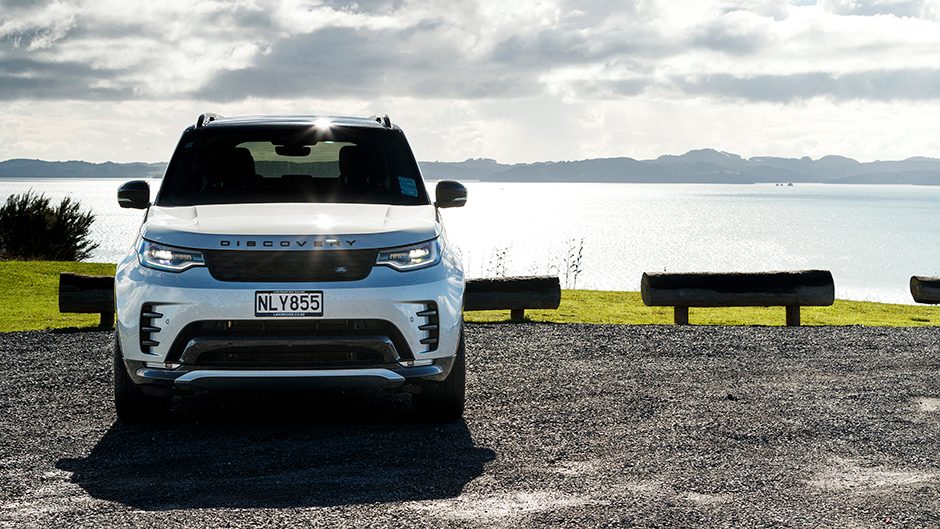As luxury rigs go, the Discovery has an impressive list of attributes. It’s a Land Rover so can conquer all paths with its AWD hardware. It can tow up to 3500kgs, has seats to accommodate seven adults, and does everything in a refined manner. It’s recently been updated, but is it enough to get current owners to upgrade?
The addition of extra tech features will likely excite the teenagers in your brood as the Bluetooth can now connect with two smartphones simultaneously and both Apple and Android are supported. The interior sports the most obvious changes, the new 11.4-inch Pivi Pro infotainment touchscreen now 48 per cent larger than the old one. Factor on better graphics, faster responses (especially from start-up) and generally improved ease of use, with most operations requiring just a couple of taps or swipes to achieve. The voice functionality seems to be improved too. There are Over-The-Air updates and the nav has dynamic guidance (shows you where the traffic snarl-ups are) and there is mesmerising 3D mapping.
The new dash appears featureless with the ignition switched off but everything illuminates with the new ‘hidden-until-lit’ buttons. The centre console has been cleaned up with a much improved gear selector compared with the old rotary controller. And unlike the joystick lever in some JLR product, this is actually clicks into gear first time, every time. Once in D, you can simply tap it backwards to access Sport mode, easy as. The mess of buttons for the Terrain Response AWD system has been replaced with a new knob, and hidden at the base of the centre stack is a wireless charging pad. The new steering wheel is still mammoth in diameter but has a smaller airbag and new touch-sensitive controls. These work better than some others we tried this month, as they are not so closely clumped together.

The exterior design has been massaged, though being a facelift the Discovery ‘DNA’ cues – the clamshell bonnet, the stepped roof and the chunky C-pillar – remain. Kiwi buyers of high-end rigs like a sporty look and so all models here are of the R-Dynamic flavour. These have ‘a more assertive character and purposeful stance’ with their black detailing and reprofiled bumpers that help make the Disco look wider. Other new bits include the LED lights front and rear and wheel designs.
The second-row seats are said to be reformed for more comfort and the air vents have been repositioned to the console for improved airflow (they used to be on the B-pillar). When this Discovery debuted, a party trick included powered seats in all rows. In theory it was good, being able to configure the seat layout at a push of a button but it was…a…painfully….slow…process. The front seats are still powered, naturally, but only the seat backs of the second row are now. We’d prefer them all to be manual however, as the folding system would just work more harmoniously. As such, the access to the third row isn’t great but the space back there is, accepting a pair of decent sized adults. There are charge points for all three rows, nine all told. And a total of five isofix mounting points, heaven forbid one should ever need that many.
The boot is huge in five-seater mode (1231L), if you can find the button to open the tailgate (everyone struggles the first time as it’s off to the left of the handle). They’ve persisted with the ‘powered inner tailgate’, which just gets in the way most of the time. It is however handy when you have lots of stuff in the boot, helping to prevent things from falling out when you open the boot (if you remember where that button is). It’s also a handy spot to sit and remove one’s mucky galoshes after a day at the polo. There’s not much luggage space left over in the seven-seat mode, the space quoted at 257L.

We thought this new Discovery sounded a bit ‘BMW-ish’ at first, powered as it is by the firm’s latest straight-six engine. With sequential turbos and improved variable nozzle turbines, this boosts up quickly, LR saying 90 per cent of peak torque is delivered in a second. And that’s about on the money. The idle/stop function can hamper initial response as it refires, but then it charges quickly. If you’ve a leaden foot, the surge of torque sees the Disco squat and go. The auto’s a good’un too, on the case smartly while the changes are oh-so smooth. That’s much like the ride quality, it’s fairly supple as you’d hope for an air sprung off roader.
We drove the D300 variant of the 3.0-litre six with 221kW and 650Nm of torque. The D250 offers 183kW and 570Nm, so only a bit less surge, though it’ll save you $5k. The range now starts at $119,900 for the S and tops out at the $144,900 D300 HSE. There are no petrol variants. Neither is the 48v mild hybrid tech that helps the diesels ‘meet the strictest of Euro6 emissions standards’. But vehicles only need to meet Euro5 here. Concerned about the level of PM2.5 fine particulate matter in the air? Option the $400 cabin air ionisation with PM2.5 filter and your lungs will be safe inside the Disco.
Also new is iAWD, the ‘intelligent’ system varying the torque split between front and rear axles to suit the conditions. LR says it ‘maximises traction, on-road dynamics and driveline efficiency, resulting in improved fuel economy and reduced CO2 emissions in normal driving’. All that off road hardware adds weight, and you don’t need AWD when you’re in traffic/on the motorway. This vehicle’s long term average was sitting at 11L/100km, but after a reset we managed to get it into the high 9L/100km range.

The steering is fairly easy for such a big rig, though the turning circle is on the large side. A 3D Surround Camera system provides a range of views, including a perspective of the surrounding area, to help with docking.
There’s no Dynamic mode for the Discovery as it’s not that sort of vehicle. The Adaptive Dynamics employs continuous variable damping to help keep body movements in check while still keeping ride comfort in mind. It does a pretty good job considering. Ultimately though the stability control helps out when push results in shove, applying the brakes at each corner, and neutering the flow of Newtons to help keep you left of the line.
Competitors are few if you genuinely need the rugged road capability, and it undercuts the big GLS and X7 on price, neither of which are much chop off piste. If it’s just something to ferry the kids around in, which this is very good at, we suggest also trying the XC90, a more wieldy large SUV for the city and slightly cheaper too.
| Model | Land Rover Discovery R-Dynamic SE D300 |
| Price | $134,900 |
| Engine | 2996cc, IL6, TDI, 221kW/650Nm |
| Drivetrain | 8-speed auto, all-wheel drive |
| Fuel Use | 7.8L/100km |
| C02 Output | 205g/km |
| 0-100km/h | 7.185sec |
| Weight | 2517kg |


